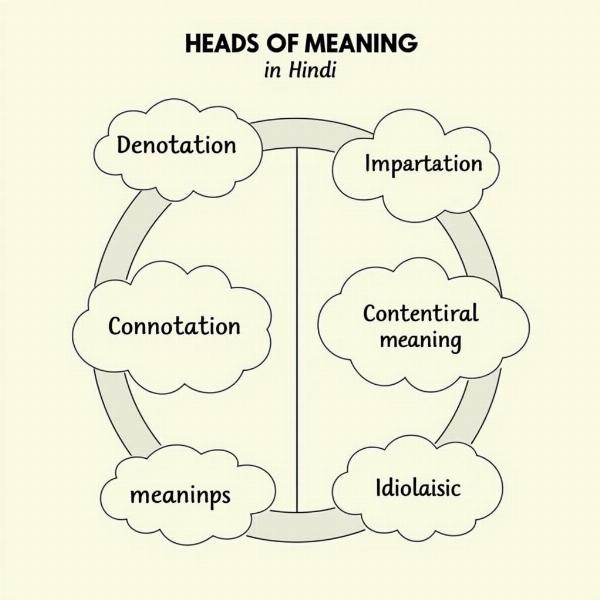Understanding the different “heads of meaning” in Hindi is crucial for anyone looking to master the nuances of this beautiful and complex language. Whether you’re a student, a translator, or simply a language enthusiast, grasping these core concepts will significantly enhance your ability to communicate effectively and appreciate the richness of Hindi vocabulary. This article will delve into the various “heads of meaning” in Hindi, providing clear explanations and practical examples to help you navigate the intricacies of the language.
Exploring the Core Concepts of Heads of Meaning
In Hindi, “heads of meaning” (अर्थ के शीर्षक – arth ke shirshak) refer to the different semantic categories or facets of meaning that a word can possess. These categories help us understand how words relate to each other and how they contribute to the overall meaning of a sentence. They are essential for disambiguating words with multiple meanings and for appreciating the depth and subtlety of Hindi vocabulary.  Heads of Meaning Diagram
Heads of Meaning Diagram
Different Heads of Meaning in Hindi
Hindi, like many other languages, possesses several key heads of meaning. Let’s explore some of the most important ones:
Denotation (वाच्यार्थ – vachyarth)
This refers to the literal or dictionary definition of a word. It is the most basic and straightforward aspect of meaning. For example, the denotation of the word “कमल” (kamal) is “lotus.”
Connotation (लक्ष्यार्थ – lakshyarth)
Connotation refers to the implied or suggested meaning of a word, often associated with cultural or emotional nuances. While “कमल” (kamal) denotes a lotus, it can also connote purity, beauty, and spiritual enlightenment in Hindu culture.
Contextual Meaning (प्रसंगार्थ – prasangarth)
The meaning of a word can change depending on the context in which it is used. For example, the word “जाना” (jana) can mean “to go,” “to know,” or “to understand” depending on the sentence.
Idiomatic Meaning (मुहावरेदार अर्थ – muhaavredar arth)
Idioms are expressions whose meanings cannot be deduced from the individual words. “हाथ धोना” (haath dhona), literally “to wash one’s hands,” idiomatically means “to give up on something.”
Technical Meaning (तकनीकी अर्थ – takniki arth)
Certain words have specialized meanings within specific fields. For example, “सर्वर” (server) has a specific technical meaning in the context of computer science.
Why are Heads of Meaning Important?
Understanding these different heads of meaning is crucial for accurate communication and effective translation. nazar battu meaning in hindi It allows us to avoid misinterpretations and appreciate the subtle nuances of the language. hindi meaning of summit This knowledge is particularly valuable for anyone working with Hindi texts, whether they are literary works, legal documents, or technical manuals. stone age meaning in hindi Moreover, understanding “heads of meaning” helps us appreciate the cultural and historical context embedded within the language. lathe machine parts name in hindi
Conclusion
Mastering the concept of “heads of meaning in Hindi” is essential for anyone seeking to develop a deep understanding of the language. By recognizing the different facets of meaning – denotation, connotation, context, and idiomatic usage – we can unlock the true richness and complexity of Hindi vocabulary. antlers meaning in hindi This understanding is paramount for effective communication, accurate translation, and a deeper appreciation of the cultural nuances embedded within the language.
FAQ
- What is the difference between denotation and connotation? Denotation is the literal meaning of a word, while connotation is the implied or suggested meaning.
- Why is contextual meaning important? Contextual meaning helps us understand the specific meaning of a word based on the surrounding words and sentences.
- What are some examples of idioms in Hindi? Examples include “हाथ धोना” (haath dhona – to give up) and “ऊँट के मुँह में जीरा” (oont ke munh mein jeera – a drop in the ocean).
- How can I improve my understanding of heads of meaning? By reading extensively, paying attention to context, and consulting dictionaries and glossaries.
- Why is it important to understand technical meanings? It is essential for accurate communication in specialized fields like medicine, engineering, and law.
- How do heads of meaning relate to translation? Understanding heads of meaning is crucial for accurate and nuanced translations.
- Where can I learn more about Hindi vocabulary? Resources like dictionaries, online courses, and language learning apps can help.
Meaning-Hindi.in is your trusted partner for all your Hindi translation needs. We offer a wide range of professional translation services, including business and commercial document translation, certified and legal document translation, technical and user manual translation, website and localization services, educational and academic document translation, express translation, and specialized industry translation. Contact us today for a free quote at [email protected] or call us at +91 11-4502-7584. Meaning-Hindi.in is committed to delivering accurate and culturally sensitive translations that bridge language barriers and facilitate effective communication.